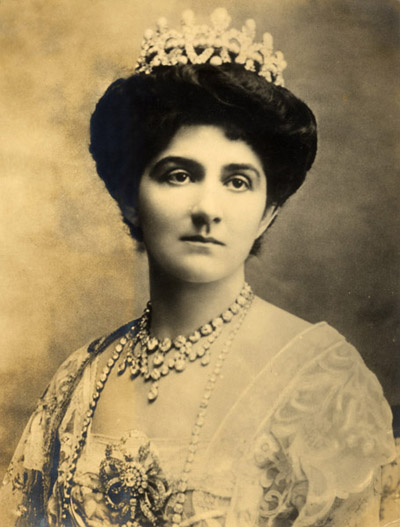Victor Emmanuel II became king upon the unification of Italy, largely accomplished by Garibaldi. He became king on March 17, 1861. Prior to that he was the Duke of Savoy, then King of Sardinia. He was a son of Maria Theresa of Austria. He married his cousin, Adelheid Habsburg of Austria(a cousin, below) He died on January 9, 1878.
Umberto I (one of eight children) became king upon the death of his father on January 9, 1878 and died on July 29th 1900 as the result of a second assassination attempt by Anarchists who were angry with his Ultra-Conservative policies and his support of a massacre of rioters in Milan. The riots were in response to famine and rising bread prices in the country. His Queen Consort was Margherita of Savoy.(below)(Margherita Pizza)
Victor Emmanuel II became king on July 29th 1900 and died on December 28th 1947. He abdicated in favor of his son on May 9th 1946 after his embarrassing association with the Fascists during Mussolini's rule of the country. Married to Elena of Montenegro(below), their daughter Mafalda died in Buchenwald concentration camp after the king arrested Mussolini and they fled to Egypt to exile. Elena is best remembered for her involvement in rescue efforts and nursing following the Great Earthquake in Messina in 1908.
Umberto II became king upon the abdication of his father on May 9th 1946. He was deposed on June 12th 1946. As Italy became a republic all titles were no longer valid. He died on March 18th 1983. Umberto and his queen Maria Jose of Belgium held their title for 35 days before the referendum to abolish the monarchy removed them from power. They were referred to as the May king and the May queen. They separated and did not live together after this. There were reports that Umberto was Homosexual. He remained in exile in Portugal for the rest of his life. A good portrait of Maria Jose(below) is not available from Wikipedia, but a search of her name will show you a number of them.


This portrait is in front of his father's portrait, Though exiled and living in Geneva most of his life, he and his family were allowed to return to Italy after formally renouncing titles and renouncing possessions in Italy. He has been a constant embarrassment, arrested for wrongful death, corruption etc., his son has distanced himself from him. Born February 13th 1937. Married to Maria Ridolfi-Doria. Do a name search to see portraits of her.
informational blog and I will happily remove the image.
He is married to Clotilde Courau(below), a French actress.

Thanks to Wikipedia for most of the images. Wikipedia is a very worthwhile organization. Anyone with good knowledge or research skills on a subject of interest to the public should consider joining Wikipedia and contributing information or editorial skills to it. Also, consider financial gifts to Wikipedia to help continue its free status.
Italy, through much of its history was not a single nation. Papal states, with territory larger or smaller in different periods, duchies, small republics, etc. characterized the peninsula for most of its history. The fact that Italy is quite mountainous contributed to the isolation of one region from another. There were constant squabbles between these tiny "countries" which left the entire area in nearly constant turmoil. Outside countries also tried to grab off pieces of the peninsula, or the entire area. France tried to take it over, Austria's Hapsburgs had territory or alliances that made them virtual rulers of large areas. Grumbling over the power of the popes encouraged takeover attempts over and over again.
Through many hundreds of years, the south was more stable with Naples and the southern regions forming a country, Sicily forming another, and the two together as the Kingdom of the Two Sicilies, changing hands on occasion from French and Spanish etc.
It was not until the first half of the 19th century that a serious attempt to unify the peninsula began. After the seeds of a nation were cobbled together in the north, Garibaldi started in Marsala, Sicily with his red shirt troops and virtually swept through the country from the south, as the proto-nation pushed south to meet him, putting together a united kingdom of Italy for Victor Emmanuel II of Savoy and Sardinia to rule in 1860. The papal states fell, leaving only Rome of his domains still in the pope's hands. The Nation of Italy was officially proclaimed. Venice and the northeast were added in 1866, and by 1871 Rome finally fell and became the capital. By treaty, Vatican city became the city state that it is today. More territory in the north east was added after the first world war. It is strange to think that the major part of the country was formed only 17 years before Grammie was born, and only really completed when she was in her thirties. It was abolished by the time she was fifty....Three of the four kings.... two world wars a dozen republican governments, all within her lifetime









No comments:
Post a Comment